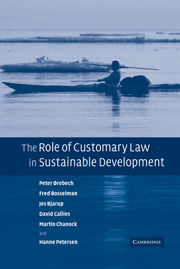Book contents
- Frontmatter
- Contents
- Preface
- Acknowledgements
- Table of cases
- List of international conventions
- Introduction
- 1 The linkage between sustainable development and customary law
- 2 Three case studies from Hawaii, Norway and Greenland
- 3 Social interaction: the foundation of customary law
- 4 How custom becomes law in England
- 5 How custom becomes law in Norway
- 6 Adaptive resource management through customary law
- 7 The place of customary law in democratic societies
- 8 Customary law, sustainable development and the failing state
- 9 Towards sustainability: the basis in international law
- 10 The case studies revisited
- 11 The choice of customary law
- 12 Conclusion: customary law in a globalizing culture
- References
- Index
- Authors index
Introduction
Published online by Cambridge University Press: 18 December 2009
- Frontmatter
- Contents
- Preface
- Acknowledgements
- Table of cases
- List of international conventions
- Introduction
- 1 The linkage between sustainable development and customary law
- 2 Three case studies from Hawaii, Norway and Greenland
- 3 Social interaction: the foundation of customary law
- 4 How custom becomes law in England
- 5 How custom becomes law in Norway
- 6 Adaptive resource management through customary law
- 7 The place of customary law in democratic societies
- 8 Customary law, sustainable development and the failing state
- 9 Towards sustainability: the basis in international law
- 10 The case studies revisited
- 11 The choice of customary law
- 12 Conclusion: customary law in a globalizing culture
- References
- Index
- Authors index
Summary
When the authors of this book told people that we were working on a book about customary law and sustainable development, we often encountered puzzled looks. A few people said, “What's sustainable development?” Many more asked, “What's customary law?” Others wondered how two such disparate topics could be related?
Chapter 1 begins by briefly discussing the meaning of each of the two phrases, and suggests the nature of the linkage between them. Here we raise the question of whether and under what conditions customary law might be looked to as a way of developing natural resources in a sustainable and precautionary manner. Recent research by Elinor Ostrom and others has called attention to the key role that common-pool resources play in sustainable solutions to natural resource management. Many customary law systems employ an intricate mix of public, private and common property concepts. Sometimes such a mix can better achieve sustainability in situations where a system that adamantly relied on private or public property alone may have failed.
Chapter 2 discusses three illustrative instances of the use of customary law in natural resource management in three different areas of the world: Hawaii, Northern Norway and Greenland. By putting the case studies up front, it is our intention not only to describe the conflicts briefly, but also to get in just “enough” law so that readers can proceed to the more detailed chapters of their choice.
- Type
- Chapter
- Information
- The Role of Customary Law in Sustainable Development , pp. 1 - 11Publisher: Cambridge University PressPrint publication year: 2006

